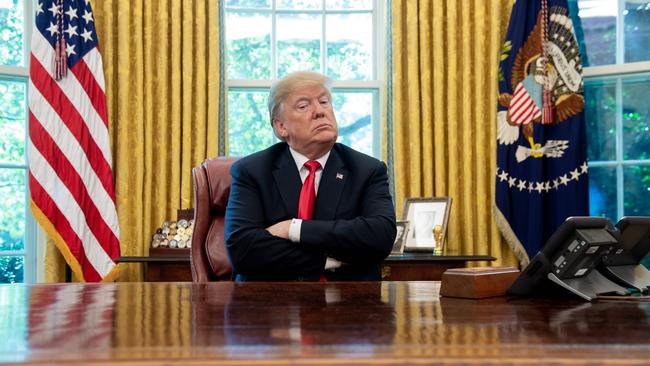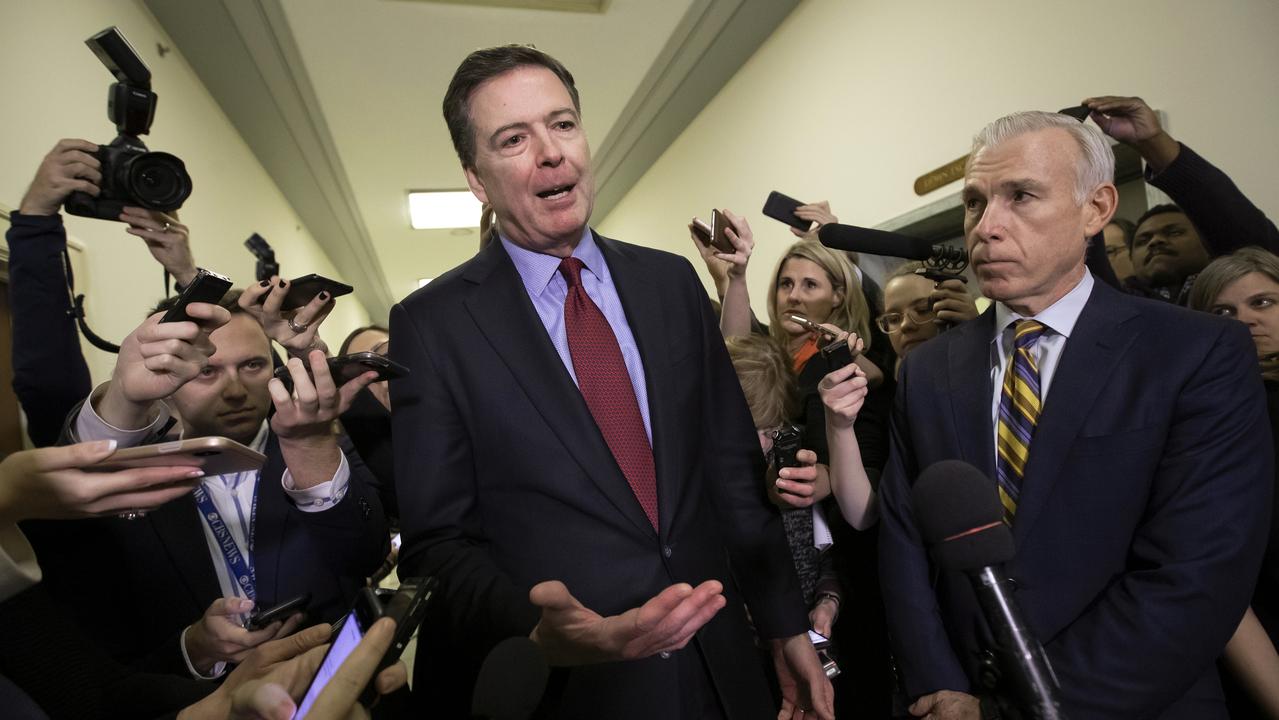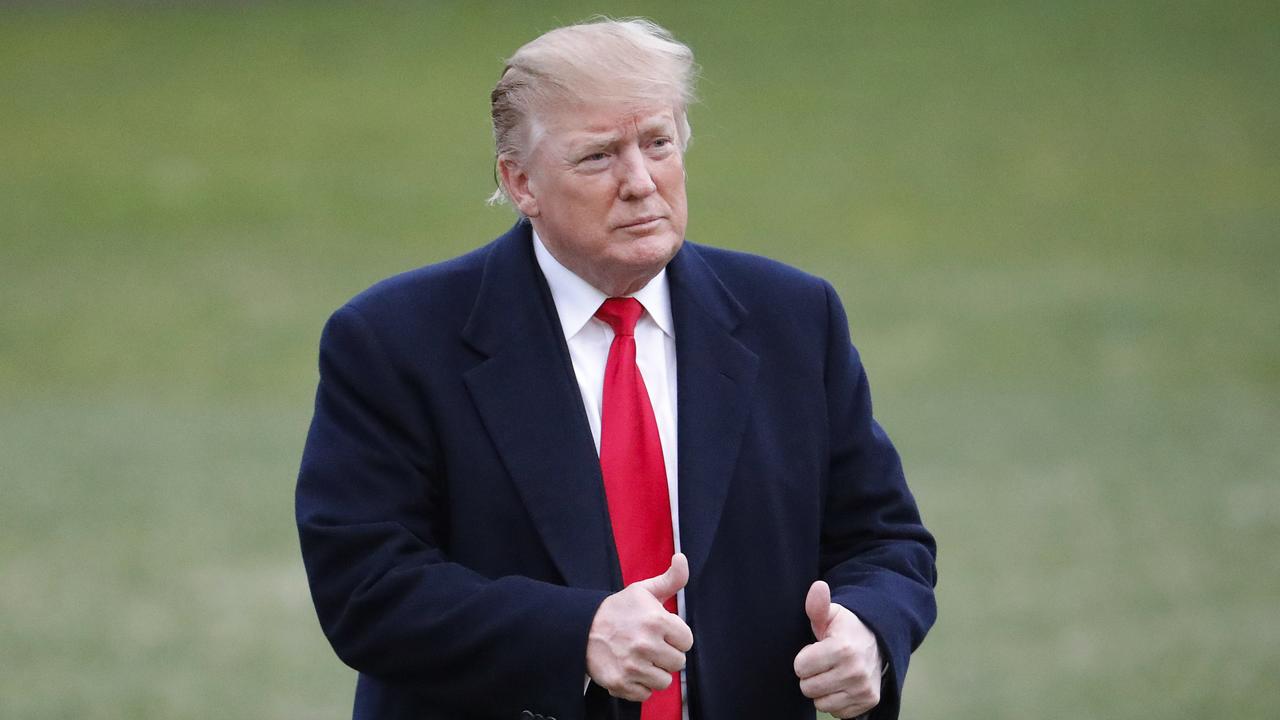Challenges mount for disrupter-in-chief Donald Trump
It has been a turbulent year for Donald Trump — and the most difficult phase of his presidency hasn’t even started yet.

Donald Trump flies to his Mar-a-Lago resort in Florida for his Christmas break this weekend, leaving behind the most turbulent year of his presidency, with the promise of an even tougher one ahead. It comes when the President is as isolated as he has ever been during his time in office.
He goes on holiday a day after his defence secretary, Jim Mattis, quit over disagreements with the President including Trump’s unilateral decision this week to withdraw all US troops from Syria.
It also comes as special counsel Robert Mueller is circling ever closer in his long-running Russia investigation and with a rogues’ gallery of Trump’s former colleagues facing jail.
These include Trump’s former personal lawyer Michael Cohen, his former campaign manager Paul Manafort, former deputy campaign chairman Rick Gates and possibly his former national security adviser Michael Flynn.
When Trump returns to work, he will confront a new and more difficult phase of his presidency: a divided government, with the Democrats taking over control of the House of Representatives.
Inevitably this will require Trump to weather a raft of new investigations into his conduct and finances, as well as likely gridlock on his agenda. It raises the very real prospect that we have already seen the high-water mark of his presidency in terms of concrete achievements such as his tax reform bill and the appointment of conservative judges to the Supreme Court and lower courts.
But as 2018 ends, Trump at least can boast that he has done well as the disrupter-in-chief he promised to be. From the trade war he has sparked with China and his allies to his assaults on the FBI and the Justice Department, his criticism of the Federal Reserve’s interest rate policy and his embrace of North Korea’s Kim Jong-un, he has delivered the unexpected at almost every turn.
This has neither destroyed him nor strengthened him. He ends the year with an average approval rating of almost 43 per cent, little changed from when he took over the presidency. His support among his base remains steadfastly loyal, with about 84 per cent of Republicans approving of the job he is doing. But, even so, Trump has never been more vulnerable.
The final counts in undecided house seats after the November 6 mid-term elections swung almost entirely towards the Democrats, making it a more conclusive victory than it appeared on the night.
Although the Republicans increased their Senate majority by two seats to 53-47, they lost a solid 40 seats in the house, along with seven governorships and hundreds of seats in state legislatures.
Most concerning for Trump is that the Democrats won in Pennsylvania, Wisconsin and Michigan — key states that he took from the Democrats in 2016. If that pattern were to be repeated in 2020, he would lose the election.
Trump begins the new year facing a series of daunting challenges that will shape the remainder of his term. The most dangerous of these is Mueller’s secretive and sprawling Russia investigation, now in its final stages, which appears to be looping ever closer to the President.
Republicans argue — as Democrats did in the context of Kenneth Starr’s investigations into the Clintons in the 1990s — that Mueller wrongly has exceeded his initial brief to examine Russia’s attempts to influence the 2016 election. Mueller’s investigation, which began in May last year, has since broadened to include issues such as possible obstruction of justice by the President, as well casting a much wider net around a question of collusion between the Trump campaign and Moscow.
Trump has tried to pre-empt what is likely to be a damning final report by setting the scene for it to be dismissed by his supporters as fake news. He has stepped up his attacks on Mueller and his team, portraying them as a pitchfork-wielding political lynch mob, conducting a Democrat-led witch-hunt based on lies extracted under oath. But while Trump has described the Mueller inquiry as a waste of taxpayer money, the inscrutable former FBI chief has delivered surprisingly concrete results so far. Mueller already has charged 33 people, including 26 Russian nationals accused of involvement in attempts to influence the 2016 election in favour of Trump via hacked emails and phony social media posts. In the US, his inquiry also has led to charges against Flynn, Manafort, Gates and Trump’s former foreign policy adviser, George Papadopoulos, among others.
The bottom line of this outcome is that we now know — contrary to Trump’s initial assertions — that Russia’s attempts to influence the US election were far broader and more sophisticated than was appreciated at the time.
A report presented to the Senate this week shows how Moscow used all major social media platforms to deliver carefully targeted messages via words, video and images to encourage voters to support Trump. Mueller’s indictments also reveal the extent of the Russian hacking and leaking of Democrat emails in 2016.
But the potential danger to Trump lies in Mueller’s findings about the separate questions of collusion and obstruction of justice. Trump is adamant that there was no collusion between himself and Russia in any form during the 2016 campaign, and he points out that there is no public evidence of any such collusion involving his team.
Yet Mueller’s investigation has shown that members of Trump’s team — from former attorney-general Jeff Sessions to Flynn, Manafort, Gates and Papadopoulos — had far closer dealings with Russian officials than they initially admitted. This does not mean there was collusion with Moscow to help influence the election, and nothing at this point appears to implicate Trump. But it does give Mueller far more to investigate than was assumed during the early stages of his probe.
In the end, the greatest danger for Trump lies in how Mueller assesses the question of obstruction of justice. Did Trump’s alleged request to FBI chief James Comey that he drop the investigation into Flynn constitute obstruction of justice? And what about Trump’s decision to sack Comey, given that Comey was leading the FBI’s Russia probe?
Mueller has extracted written answers from Trump on other aspects of the Russia probe but has not submitted questions to the President on matters relating to obstruction of justice, preferring to interview him personally. But the White House has refused a face-to-face interview, with Trump’s lawyer, Rudy Giuliani, declaring this week that such an interview would occur “over my dead body. But, you know, I could be dead.” This means Mueller must decide whether to subpoena the President — an unprecedented action that Trump has suggested would go all the way to the Supreme Court.
Mueller may consider he already has enough evidence in Trump’s public tweets and through other witnesses to make his final judgment.
Either way, it is considered unlikely that Mueller in his findings will seek to indict Trump, even if he believes the President is guilty of obstructing justice. Any move to indict Trump would be legally fraught. The Justice Department previously has ruled that a sitting president cannot be charged with a crime. However, Mueller’s findings will help to determine whether the Democrats choose to embark on the process of impeachment next year.
Trump’s other legal concern, separate to the Mueller investigation, is whether he faces legal scrutiny over his alleged direction to his then lawyer, Cohen, to breach campaign finance laws by paying hush money to two women who allegedly had affairs with Trump. History suggests this won’t be an issue for Trump — there is no precedent for a successful prosecution of a politician for such an offence, much less a president.
Apart from the investigations, other key challenges confront Trump in early in the new year. The most significant of these is his ongoing trade war with China, which has reached an uneasy stalemate as both countries seek a way to negotiate a solution after a series of tit-for-tat tariff rises.
Trump’s willingness to call Beijing out over its closed markets and discriminatory trade practices eventually may lead to long-term change that would benefit not only the US but countries such as Australia. But with China so far refusing to budge beyond making vague promises of buying more US goods, Trump will face a decision early in the new year about how far to push this dispute.
Will the President settle for a partial win by extracting firm commitments from China to buy more US products to reduce the yawning trade imbalance? Or will he demand fundamental wholesale changes to China’s trading system as his price for peace in the trade war?
This decision will be critical to Australia and to increasingly skittish world markets. It will be made as the administration has become sharply more hawkish on overall US-China relations. In recent months the White House has openly and loudly chided Beijing for its interference in US domestic politics and society, its brinkmanship in the South China Sea and its ongoing economic espionage to steal US secrets and technology.
Next year also will be the first test of Trump’s ability and willingness to work with Democrats to achieve his agenda. It’s a challenge he has never had to worry about, enjoying the luxury of a Republican majority in both houses of congress for his first two years in office.
Despite this, Trump has managed to secure only one major legislative win: his tax reform package. Other election promises remain unfulfilled. These include his pledge to increase infrastructure spending across the country, his commitment to build a wall on the Mexican border alongside other restrictive immigration measures, and his promised dismantling of Barack Obama’s Affordable Care Act.
If Trump could not achieve these reforms with a Republican-controlled congress, it is difficult to see how he will be able to do so with Democrats controlling the house from January.
Trump and the likely Democrat house leader, Nancy Pelosi, have spoken of the need for a bipartisan approach in the divided congress. Yet their public meeting in the Oval Office last week quickly descended into a rabble of partisan shots — an ominous indicator of what may lie ahead.
On the international stage, Trump increasingly has disregarded the counsel of his advisers as he backs his own gut instincts on defence and foreign policy. His decision this week to withdraw all US troops from Syria was made in defiance of the advice given to him by his national security team, including Mattis. It was clearly the last straw for the former general, who delivered his resignation to the President within 24 hours. This is a blow for Trump. Mattis was considered one of the most experienced moderating forces in the White House, able to move Trump away from his more impulsive ideas.
Trump’s deliberately disruptive “America first” strategy across trade, defence and issues such as climate change means he cuts an increasingly solitary figure at forums such as the recent G20 meeting in Argentina. His vocal criticism of allied leaders such as Germany’s Angela Merkel, France’s Emmanuel Macron and Canada’s Justin Trudeau contrasts with his cordial approach to authoritarian leaders, from Russia’s Vladimir Putin to Saudi Arabia’s Mohammed bin Salman and North Korea’s Kim.
Yet Trump’s erratic approach to allies also has allowed him to speak some home truths to long-time friends. He rightly has attacked NATO countries for failing to pay their share of money for the West’s collective defence after relying too heavily on the US for decades. He also skewered the EU for its highly protected markets. In Asia, Trump faces a herculean task next year of trying to salvage his much-touted nuclear deal with North Korea.
The President was widely lauded for getting Kim to attend their Singapore summit in June — the first meeting between a North Korean leader and a sitting US president. But since then it has become increasingly clear that the two leaders misunderstood each other or that Kim is already flouting the terms of their apparent agreement on the denuclearisation of North Korea.
This week, in the latest of a series of escalating threats, Pyongyang warned it “will block the path to denuclearisation on the Korean peninsula forever” if the US continues to levy additional sanctions as part of its “maximum pressure” strategy. Although Trump and Kim have been civil towards each other and there are plans for a second summit early next year, denuclearisation has become bogged down before it even begins.
This comes amid reports that North Korea continues to develop its missile sites. Next year Trump will have to decide whether Kim is willing to act on his promise or whether their Singapore summit was just another bizarre chapter in North Korea’s long history of deception.
The President will have to make all of these difficult decisions in a White House where key advisers have to contend with a revolving door.
The resignation of Mattis along with chief of staff John Kelly takes the number of high-profile departures from the White House to 34 — the highest number in more than 40 years. according to political website Axios.
When Time magazine placed Trump at No 2 in its Person of the Year shortlist, it noted that his greatest impact in 2018 had come not from conventional actions but from unconventional ones: “he has been a disrupter, stoking political divisions, breaking institutional norms and weakening the power of the federal government from within”.
Given the challenges that lie ahead, 2019 promises to be the most volatile year yet for America’s disrupter-in-chief.
Cameron Stewart is also US contributor for Sky News Australia.




To join the conversation, please log in. Don't have an account? Register
Join the conversation, you are commenting as Logout